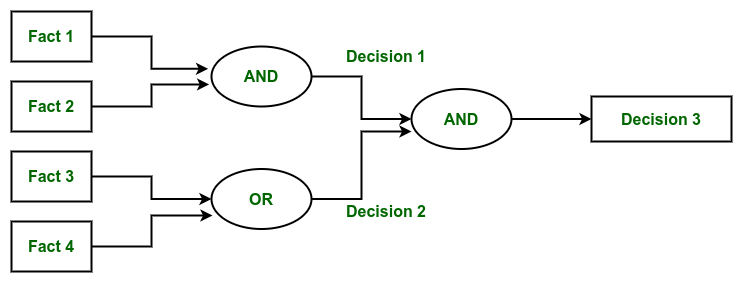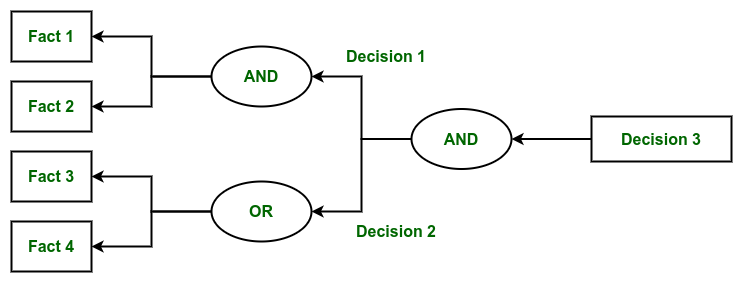- 1. Rule-Based Expert Systems
- 2. Frame-Based Expert Systems
- 3. Fuzzy Logic Systems
- 4. Neural Network-Based Expert Systems
- 5. Neuro-Fuzzy Expert Systems
- 1. Forward Chaining
- 2. Backward Chaining
Understanding Expert Systems in AI
An expert system is AI software that uses knowledge stored in a knowledge base to solve problems that would usually require a human expert thus preserving a human expert’s knowledge in its knowledge base. They can advise users as well as provide explanations to them about how they reached a particular conclusion or advice.
Knowledge Engineering is the term used to define the process of building an Expert System and its practitioners are called Knowledge Engineers . The primary role of a knowledge engineer is to make sure that the computer possesses all the knowledge required to solve a problem. The knowledge engineer must choose one or more forms in which to represent the required knowledge as a symbolic pattern in the memory of the computer.
Types of Expert Systems in AI
In AI, expert systems are designed to emulate the decision-making abilities of human experts. They are categorized based on their underlying technology and application areas. Here are the primary types of expert systems in AI:
1. Rule-Based Expert Systems
- Description : Use a set of “if-then” rules to process data and make decisions. These rules are typically written by human experts and capture domain-specific knowledge.
- Example : MYCIN , an early system for diagnosing bacterial infections.
2. Frame-Based Expert Systems
- Description : Represent knowledge using frames, which are data structures similar to objects in programming. Each frame contains attributes and values related to a particular concept.
- Example : Systems used for knowledge representation in areas like natural language processing.
3. Fuzzy Logic Systems
- Description : Handle uncertain or imprecise information using fuzzy logic , which allows for partial truths rather than binary true/false values.
- Example : Fuzzy control systems for managing household appliances like washing machines and air conditioners.
4. Neural Network-Based Expert Systems
- Description : Use artificial neural networks to learn from data and make predictions or decisions based on learned patterns. They are often used for tasks involving pattern recognition and classification.
- Example : Deep learning models for image and speech recognition.
5. Neuro-Fuzzy Expert Systems
- Description : Integrate neural networks and fuzzy logic to combine the learning capabilities of neural networks with the handling of uncertainty and imprecision offered by fuzzy logic. This hybrid approach helps in dealing with complex problems where both pattern recognition and uncertain reasoning are required.
- Example: Automated control systems that adjust based on uncertain environmental conditions or financial forecasting models that handle both quantitative data and fuzzy inputs.
Examples of Expert Systems in AI
There are many examples of an expert system. Some of them are given below:
1. MYCIN
- Overview : MYCIN is one of the earliest and most influential expert systems developed in the 1970s. It was specifically designed for medical diagnosis.
- Functionality : MYCIN uses backward chaining to diagnose bacterial infections, such as meningitis and bacteremia. It identifies the bacteria causing the infection by asking the doctor a series of questions about the patient’s symptoms and test results.
- Significance : Although not used clinically, MYCIN greatly influenced the development of medical expert systems.
2. DENDRAL
- Overview : DENDRAL is another pioneering expert system, developed in the 1960s, and is regarded as one of the first successful AI systems in the field of chemistry.
- Functionality : DENDRAL was designed to analyze chemical compounds. It uses spectrographic data (data obtained from spectroscopy) to predict the molecular structure of a substance.
- Significance : DENDRAL revolutionized chemical research by automating the analysis of mass spectrometry data.
3. R1/XCON
- Overview : R1, also known as XCON, was developed in the late 1970s by Digital Equipment Corporation (DEC) and is one of the most commercially successful expert systems.
- Functionality : R1/XCON was used to configure orders for new computer systems. It would select the appropriate hardware and software components based on the customer’s requirements.
- Significance : R1/XCON streamlined system configuration, saving DEC millions by reducing errors and improving efficiency.
4. PXDES
- Overview : PXDES is an expert system designed for the medical field, particularly in the diagnosis of lung cancer.
- Functionality : PXDES could analyze patient data, including imaging results, to determine both the type and the stage of lung cancer. It helps in deciding the best course of treatment based on the patient’s specific condition.
- Significance: PXDES aids in accurate, timely diagnoses, improving treatment decisions in oncology.
5. CaDet
- Overview : CaDet is a clinical support system developed to assist in the early detection of cancer.
- Functionality : CaDet can identify potential signs of cancer in its early stages by analyzing patient data and symptoms. It works by comparing patient data with known patterns and indicators of cancer.
- Significance : Early detection by CaDet enhances survival rates by enabling prompt treatment.
6. DXplain
- Overview : DXplain is a medical expert system developed at Massachusetts General Hospital, used as a clinical decision support tool.
- Functionality : DXplain suggests possible diseases based on the symptoms and findings provided by a doctor. It acts as a reference tool, offering a differential diagnosis list that doctors can use to check their own diagnoses.
- Significance: DXplain broadens diagnostic possibilities, helping medical professionals consider rare conditions.
Components and Architecture of an Expert System
- Knowledge Base: The knowledge base represents facts and rules. It consists of knowledge in a particular domain as well as rules to solve a problem, procedures and intrinsic data relevant to the domain.
- Inference Engine: The function of the inference engine is to fetch the relevant knowledge from the knowledge base, interpret it and to find a solution relevant to the user’s problem. The inference engine acquires the rules from its knowledge base and applies them to the known facts to infer new facts. Inference engines can also include an explanation and debugging abilities.
- Knowledge Acquisition and Learning Module: The function of this component is to allow the expert system to acquire more and more knowledge from various sources and store it in the knowledge base.
- User Interface: This module makes it possible for a non-expert user to interact with the expert system and find a solution to the problem.
- Explanation Module: This module helps the expert system to give the user an explanation about how the expert system reached a particular conclusion.

Architecture of an Expert System
How Expert Systems Work?
Expert systems operate by following a structured approach:
- Input Data : Users provide data or queries related to a specific problem or scenario.
- Processing : The inference engine processes the input data using the rules in the knowledge base to generate conclusions or recommendations.
- Output : The system presents the results or solutions to the user through the user interface.
- Explanation : If applicable, the system explains how the conclusions were reached, providing insights into the reasoning process.
Reasoning Strategies used by Inference Engine
Forward Chaining and Backward Chaining , which are two fundamental methods for processing information and solving problems in an expert system:
1. Forward Chaining
This is a data-driven reasoning approach where the system starts with the available facts and applies rules to infer new facts or conclusions. It’s typically used to predict outcomes or determine what will happen next. An example given is predicting stock market movements.

2. Backward Chaining
This is a goal-driven reasoning approach where the system starts with a hypothesis or a goal (something to prove) and works backward to determine which facts or conditions would support that conclusion. It’s often used to diagnose issues by determining the cause of an observed effect. The examples provided include diagnosing medical conditions like stomach pain, blood cancer, or dengue.

Applications of Expert Systems
- Medical Diagnosis : Expert systems assist doctors by analyzing symptoms and medical history to suggest possible diagnoses or treatment options. For example, MYCIN, an early expert system, helped identify bacterial infections and recommend antibiotics.
- Financial Services : In finance, expert systems are used for credit scoring, fraud detection, and investment advice. They analyze financial data and patterns to make informed decisions.
- Technical Support : Expert systems can troubleshoot and provide solutions for technical issues. They guide users through problem-solving steps based on pre-defined rules and knowledge.
- Manufacturing : In manufacturing, expert systems help optimize production processes, perform quality control, and manage inventory by analyzing data and making recommendations.
Benefits of Expert Systems
- Consistency : Expert systems provide consistent and reliable recommendations, reducing the variability that can occur with human decision-making.
- Availability : They are available 24/7 and can handle multiple queries simultaneously, providing timely assistance and support.
- Cost-Effectiveness : By automating expert-level decision-making, organizations can save on the costs associated with hiring and training human experts.
- Knowledge Preservation : Expert systems preserve valuable knowledge and expertise, making it accessible even if the original experts are no longer available.
Limitations of Expert Systems
- Knowledge Limitation : The effectiveness of an expert system depends on the completeness and accuracy of the knowledge base. If the knowledge is outdated or incomplete, the system’s performance may be compromised.
- Lack of Flexibility : Expert systems are limited to the rules and knowledge they are programmed with. They may struggle with novel or ambiguous situations that fall outside their predefined rules.
- Maintenance : Regular updates and maintenance are required to keep the knowledge base current and relevant, which can be resource-intensive.
Conclusion
Expert systems are a crucial aspect of AI, providing intelligent decision-making capabilities across various domains. By emulating human expertise, they offer valuable insights, consistent solutions, and efficiency. Despite their limitations, expert systems continue to evolve and play a significant role in advancing AI technologies.
FAQs : Expert Systems in AI
What are the 5 expert systems?
Five notable expert systems are rule based, frame based, fuzzy, neural and neuro fuzzy expert systems.
What is expert tasks in AI?
Expert tasks in AI involve solving complex problems or making decisions in specific domains, typically requiring human expertise, such as medical diagnosis or financial forecasting.
Is ChatGPT an expert system?
No, ChatGPT is not an expert system; it’s a language model based on deep learning, designed to generate text rather than relying on a fixed knowledge base and rules.
What are the layers of expert system?
The layers of an expert system typically include the knowledge base, inference engine, user interface, and explanation module.